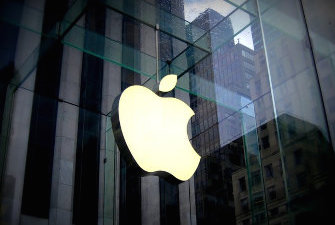 The automotive industry has been seeing some very unusual entrants from the fields of high tech in recent months, the latest of which appears to be Apple Inc. (NASDAQ:AAPL) of Cupertino, CA. Recent reports indicate that an internal project at Apple to develop a car, codenamed “Titan,” will triple the number of employees involved in order to target a 2019 shipping date target for the vehicle. Apple has not officially commented on the project but an August meeting between Apple executives and officials from California’s Department of Motor Vehicles suggests that the tech corporation is getting serious about developing what many believe will be an autonomous vehicle. Self-driving vehicle technologies have been a common theme all year in the automotive industry since storming center stage at this year’s Consumer Electronics Show. Apple’s proactive approach in meeting with state DMV officials underscores the growing regulatory concerns regarding autonomous vehicles and how they’ll affect drivers on American roads.
The automotive industry has been seeing some very unusual entrants from the fields of high tech in recent months, the latest of which appears to be Apple Inc. (NASDAQ:AAPL) of Cupertino, CA. Recent reports indicate that an internal project at Apple to develop a car, codenamed “Titan,” will triple the number of employees involved in order to target a 2019 shipping date target for the vehicle. Apple has not officially commented on the project but an August meeting between Apple executives and officials from California’s Department of Motor Vehicles suggests that the tech corporation is getting serious about developing what many believe will be an autonomous vehicle. Self-driving vehicle technologies have been a common theme all year in the automotive industry since storming center stage at this year’s Consumer Electronics Show. Apple’s proactive approach in meeting with state DMV officials underscores the growing regulatory concerns regarding autonomous vehicles and how they’ll affect drivers on American roads.
Apple has been working towards the late September release of the new iPhone models 6S and 6S Plus, a smartphone which reached its preorder limit just days before it hit the market on September 25th. New features available in the latest generation of iPhone include Live Photos, 12-mexapixel cameras and a new 3D Touch system which gives a user new ways to interact with apps by measuring the 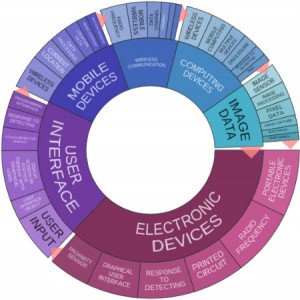 how much pressure a person uses when touching the screen. On the same day that the iPhone 6S is first sold in stores, T-Mobile US (NYSE:TMUS) will begin selling the Apple Watch along with rival telecommunications company Sprint Corp. (NYSE:S).
how much pressure a person uses when touching the screen. On the same day that the iPhone 6S is first sold in stores, T-Mobile US (NYSE:TMUS) will begin selling the Apple Watch along with rival telecommunications company Sprint Corp. (NYSE:S).
A frequent applicant for patents from the U.S. Patent and Trademark Office, Apple placed 13th overall last year among global corporations with 2,003 U.S. patents earned from the USPTO, a 12.8 percent increase over its patent totals from 2013. In the three months prior to this writing, Apple earned 593 patents from the USPTO, a pace of innovation that would outstrip Apple’s 2014 patent totals. The text cluster posted here, created by Innography, shows a unsurprisingly large amount of activity in electronic devices, mobile devices, user interfaces and wireless communication.
[Companies-1]
Apple’s Issued Patents: From Virtual Musical Instruments to Streamlined Transportation Services
 In searching through the patents most recently issued to Apple, we took note of a trio of patents showcasing Apple’s interest in developing better digital systems for music. U.S. Patent No. 9105260, entitled Grid-Editing of a Live-Played Arpeggio, protects a computer-implemented method of receiving a set of performance data corresponding to a plurality of MIDI-based notes, receiving input data requesting a change to the set of performance data, changing the first set of performance data, receiving a second set of performance data corresponding to a second plurality of MIDI-based notes and applying changes made to the first set of performance data to the second set in real-time. This innovation provides an arpeggiator, often used on synthesizers to arpeggiate a played chord, which can be applied across a broad spectrum of applications. A novel digital tool for playing musical chords is also at the center of U.S. Patent No. 9129584, titled Method of Playing Chord Inversions on a Virtual Instrument. It claims a user interface implemented on a touch-sensitive display for a virtual musical instrument which includes chord touch regions corresponding to a base chord and divided into a plurality of touch zones associated with a different harmonic configuration of the base chord; each touch zone is configured to detect two or more gesture articulations. This invention is designed to improve the experience of playing virtual instruments among those musicians who have a knowledge of musical theory while also
In searching through the patents most recently issued to Apple, we took note of a trio of patents showcasing Apple’s interest in developing better digital systems for music. U.S. Patent No. 9105260, entitled Grid-Editing of a Live-Played Arpeggio, protects a computer-implemented method of receiving a set of performance data corresponding to a plurality of MIDI-based notes, receiving input data requesting a change to the set of performance data, changing the first set of performance data, receiving a second set of performance data corresponding to a second plurality of MIDI-based notes and applying changes made to the first set of performance data to the second set in real-time. This innovation provides an arpeggiator, often used on synthesizers to arpeggiate a played chord, which can be applied across a broad spectrum of applications. A novel digital tool for playing musical chords is also at the center of U.S. Patent No. 9129584, titled Method of Playing Chord Inversions on a Virtual Instrument. It claims a user interface implemented on a touch-sensitive display for a virtual musical instrument which includes chord touch regions corresponding to a base chord and divided into a plurality of touch zones associated with a different harmonic configuration of the base chord; each touch zone is configured to detect two or more gesture articulations. This invention is designed to improve the experience of playing virtual instruments among those musicians who have a knowledge of musical theory while also 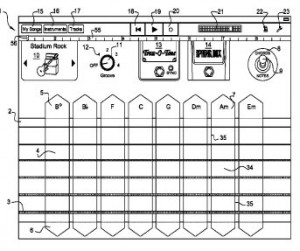 catering to beginners. The simulation of playing a traditional musical instrument is a focal point of the innovation protected by U.S. Patent No. 9111518, issued under the title Musical Systems and Methods. The method claimed here involves displaying a virtual musical instrument (VMI) with swipe regions associated with predetermined chords on a touch-sensitive graphical user interface (GUI), receiving an input corresponding to a swipe gesture on a virtual string crossing the chord swipe regions and playing notes corresponding to the virtual strings crossed by the swipe gesture. This innovation seeks to provide an optimal user interface for inputting music commands on a VMI while simulating the play of a traditional musical instrument.
catering to beginners. The simulation of playing a traditional musical instrument is a focal point of the innovation protected by U.S. Patent No. 9111518, issued under the title Musical Systems and Methods. The method claimed here involves displaying a virtual musical instrument (VMI) with swipe regions associated with predetermined chords on a touch-sensitive graphical user interface (GUI), receiving an input corresponding to a swipe gesture on a virtual string crossing the chord swipe regions and playing notes corresponding to the virtual strings crossed by the swipe gesture. This innovation seeks to provide an optimal user interface for inputting music commands on a VMI while simulating the play of a traditional musical instrument.
Improvements to touch screen interactions are continuously pursued by Apple as readers can note in U.S. Patent No. 9092086, which is titled Touch Detection Using Multiple Simultaneous Frequencies. The method for obtaining a plurality of values used to generate touch images from touch sensor circuitry disclosed here involves selecting low noise frequencies, simultaneously applying a plurality of stimulation signals including the low noise frequencies to a plurality of drive lines of the touch sensor circuitry, receiving a first sense signal from a plurality of sense lines of the touch sensor circuitry in a sense channel and demodulating the sense signals with a plurality of demodulation signals. This system is designed to improve the localized detection of touch events on a sensor panel which can sometimes suffer from voltage frequency noise caused by other electronic components like light-emitting diodes and backlight inverters.
More effective systems for contacting local emergency services in a rapid manner are discussed within U.S. Patent No. 9125038, titled Method for Obtaining Location Information for Emergency Services in Wireless Multimedia Networks. It protects a method of obtaining location information for emergency services by receiving a first request from a call session server responsive to an emergency request message from a user equipment (UE), causing a location notification message to be transmitted to the UE, receiving location information of the UE and transmitting a second request message to the call session server for requesting emergency services for the UE. This innovation enables emergency service personnel to more quickly obtain location information for a person calling for emergency responders.
 Those who find themselves often traveling about the globe may be interested to learn about Apple’s travel tech service protected by U.S. Patent No. 9087344, which is titled Systems and Methods for Accessing Travel Services Using a Portable Electronic Device. The method claimed here involves receiving a search request for businesses within an airport, obtaining flight information associated with an electronic device user which identifies the gate from which a user is scheduled to depart and the location of the gate within the airport, identifying a set of businesses located in the airport, determining a subset of businesses located within a threshold distance from the gate location and delivering a promotional content item promoting a business from the subset of businesses. This innovation seeks to serve in centralizing user interactions with travel and transportation services so that making reservations, checking in prior to a flight and other travel itinerary items are processed more simply.
Those who find themselves often traveling about the globe may be interested to learn about Apple’s travel tech service protected by U.S. Patent No. 9087344, which is titled Systems and Methods for Accessing Travel Services Using a Portable Electronic Device. The method claimed here involves receiving a search request for businesses within an airport, obtaining flight information associated with an electronic device user which identifies the gate from which a user is scheduled to depart and the location of the gate within the airport, identifying a set of businesses located in the airport, determining a subset of businesses located within a threshold distance from the gate location and delivering a promotional content item promoting a business from the subset of businesses. This innovation seeks to serve in centralizing user interactions with travel and transportation services so that making reservations, checking in prior to a flight and other travel itinerary items are processed more simply.
[Companies-2]
Patent Applications of Note: From Fuel Cells for Portable Electronics to Retroactive Location Check-Ins
Perhaps the most intriguing patent application we’ve seen in recent memory is Apple’s U.S. Patent Application No. 20150249280, entitled Fuel Cell System to Power a Portable Computing Device. It would protect a fuel cell system for a portable computing device comprising a fuel cell stack converting fuel into electrical power, a fuel source for the fuel cell stack and an interface to the portable device which includes a power link providing power to the portable device and a bidirectional communication link providing communication between the portable device and a fuel cell stack’s controller which sends fuel state information to the portable device and receives fuel cell control information. This innovation seeks to incorporate fuel cell electricity generation tech into portable computing devices for which it’s difficult to provide cost-effective and portable fuel cell systems, as the patent application itself points out. We’ve covered plenty of fuel cell technologies here on IPWatchdog but never for powering anything smaller than an automobile.
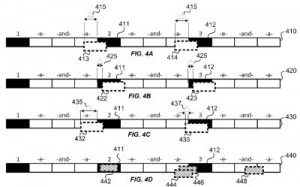 Apple continues to pursue an increased IP portfolio in virtual music performance with the filing of U.S. Patent Application No. 20150221297, titled System and Method for Generating a Rhythmic Accompaniment for a Musical Performance. The computer-implemented method disclosed here involves storing musical elements including reference accent pattern data in a database, processing performance data by receiving musical performance input data, determining the musical performance’s accent pattern and selecting a matching reference accent pattern, and then generating a musical accompaniment including musical elements configured in a predetermined pattern using the processed performance data. This invention intends to improve upon conventional drum machines and sequencers which can have a repetitive sound leading to an artificial performance.
Apple continues to pursue an increased IP portfolio in virtual music performance with the filing of U.S. Patent Application No. 20150221297, titled System and Method for Generating a Rhythmic Accompaniment for a Musical Performance. The computer-implemented method disclosed here involves storing musical elements including reference accent pattern data in a database, processing performance data by receiving musical performance input data, determining the musical performance’s accent pattern and selecting a matching reference accent pattern, and then generating a musical accompaniment including musical elements configured in a predetermined pattern using the processed performance data. This invention intends to improve upon conventional drum machines and sequencers which can have a repetitive sound leading to an artificial performance.
The Apple Pay digital wallet system has been a major selling point for Apple devices and more transaction services are reflected within U.S. Patent Application No. 20150248663, entitled Processing Payments for an Online Marketplace. The method that would be protected involves receiving an enrollment request which identifies a user account with an online marketplace, associating a serial number with the user account and transmitting the serial number to a user device for identifying the user account at a point of sale terminal. This innovation is designed to enable users to complete transactions on an online marketplace using a mobile device and without having to purchase a plastic card, thereby cutting down on waste.
 More efficient human-machine interface interactions similar to the 3D Touch system discussed above can be seen within U.S. Patent Application No. 20150234589, titled Device, Method, and Graphical User Interface for Selection of Views in a Three-Dimensional Map Based on Gesture Inputs. The electronic device claimed here includes a touch-sensitive surface, a display, processors and a memory storing programs which are executed for displaying a first map view from a first perspective on a display, detecting an input corresponding to an instruction to select a map object, selecting the respective map object as a target object, detecting an input corresponding to an instruction to display a second map view, replacing the first map view with the second map view which includes the target object. This invention provides a more efficient system for selecting in a three-dimensional map displayed on a touch-sensitive screen.
More efficient human-machine interface interactions similar to the 3D Touch system discussed above can be seen within U.S. Patent Application No. 20150234589, titled Device, Method, and Graphical User Interface for Selection of Views in a Three-Dimensional Map Based on Gesture Inputs. The electronic device claimed here includes a touch-sensitive surface, a display, processors and a memory storing programs which are executed for displaying a first map view from a first perspective on a display, detecting an input corresponding to an instruction to select a map object, selecting the respective map object as a target object, detecting an input corresponding to an instruction to display a second map view, replacing the first map view with the second map view which includes the target object. This invention provides a more efficient system for selecting in a three-dimensional map displayed on a touch-sensitive screen.
Social media services for Apple’s mobile devices are featured within U.S. Patent Application No. 20150264518, titled Retroactive Check-Ins Based on Learned Locations to Which the User Has Traveled. This patent application discloses a method of tracking a plurality of locations to which a mobile device moves during a time interval, storing data indicative of each location, displaying a plurality of the locations after the time interval, receiving input selecting locations presented on the display and posting information pertaining to selected locations to an Internet-based service accessible to a user. This service is intended to help users who may want to acknowledge their visit to an establishment but may be too engrossed in their activities to check-in while at the location.
If Apple automobiles seem like an unusual idea then readers might be interested to learn about a interior lighting system developed by the mobile device designer. U.S. Patent Application No. 20150225948, filed under the title Ceiling System, claims a ceiling system for a room that includes a plurality of panels each having a length extending across the length of a room and running parallel to each other with a space between each defining a trough, and then an elongated light fixture disposed within a trough and running along its length, the panels and troughs together defining a ceiling of a room. The lighting configuration described here provides even light throughout a room as well as a clean visual appearance for a ceiling.
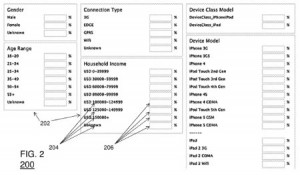 Finally, we took a moment to explore an Apple innovation which aims to improve mobile marketing campaigns for advertisers as is detailed within U.S. Patent Application No. 20150220977, which is titled Campaign Budget Controls Via User Configurable Line Specifications. It claims a computer-implemented method of identifying a request to deliver an invitation content item which corresponds to a segment in n-dimensional space associated with a campaign, obtaining line specification regarding soft spending constraints defining minimum and maximum spends associated with the campaign, determining whether the campaign is suitable for servicing the request based on the line specification and a current spend for the campaign, adding the campaign to a list of candidate campaigns in response to determining that the campaign is suitable and servicing a request using a candidate campaign. This system gives advertisers a mechanism through which they can more easily adjust line or ad orders targeting a certain demographic without requiring a burdensome amount of intervention.
Finally, we took a moment to explore an Apple innovation which aims to improve mobile marketing campaigns for advertisers as is detailed within U.S. Patent Application No. 20150220977, which is titled Campaign Budget Controls Via User Configurable Line Specifications. It claims a computer-implemented method of identifying a request to deliver an invitation content item which corresponds to a segment in n-dimensional space associated with a campaign, obtaining line specification regarding soft spending constraints defining minimum and maximum spends associated with the campaign, determining whether the campaign is suitable for servicing the request based on the line specification and a current spend for the campaign, adding the campaign to a list of candidate campaigns in response to determining that the campaign is suitable and servicing a request using a candidate campaign. This system gives advertisers a mechanism through which they can more easily adjust line or ad orders targeting a certain demographic without requiring a burdensome amount of intervention.

![[IPWatchdog Logo]](https://ipwatchdog.com/wp-content/themes/IPWatchdog%20-%202023/assets/images/temp/logo-small@2x.png)


![[Advertisement]](https://ipwatchdog.com/wp-content/uploads/2024/04/UnitedLex-May-2-2024-sidebar-700x500-1.jpg)
![[Advertisement]](https://ipwatchdog.com/wp-content/uploads/2024/04/Artificial-Intelligence-2024-REPLAY-sidebar-700x500-corrected.jpg)
![[Advertisement]](https://ipwatchdog.com/wp-content/uploads/2024/04/Patent-Litigation-Masters-2024-sidebar-700x500-1.jpg)

![[Advertisement]](https://ipwatchdog.com/wp-content/uploads/2021/12/WEBINAR-336-x-280-px.png)
![[Advertisement]](https://ipwatchdog.com/wp-content/uploads/2021/12/2021-Patent-Practice-on-Demand-recorded-Feb-2021-336-x-280.jpg)
![[Advertisement]](https://ipwatchdog.com/wp-content/uploads/2021/12/Ad-4-The-Invent-Patent-System™.png)






Join the Discussion
One comment so far.
elwood
October 4, 2015 09:33 pmToshiba did fuel cell laptops a decade ago. e.g., http://gizmodo.com/205733/toshiba-displays-fuel-cell-batteries-on-a-laptop